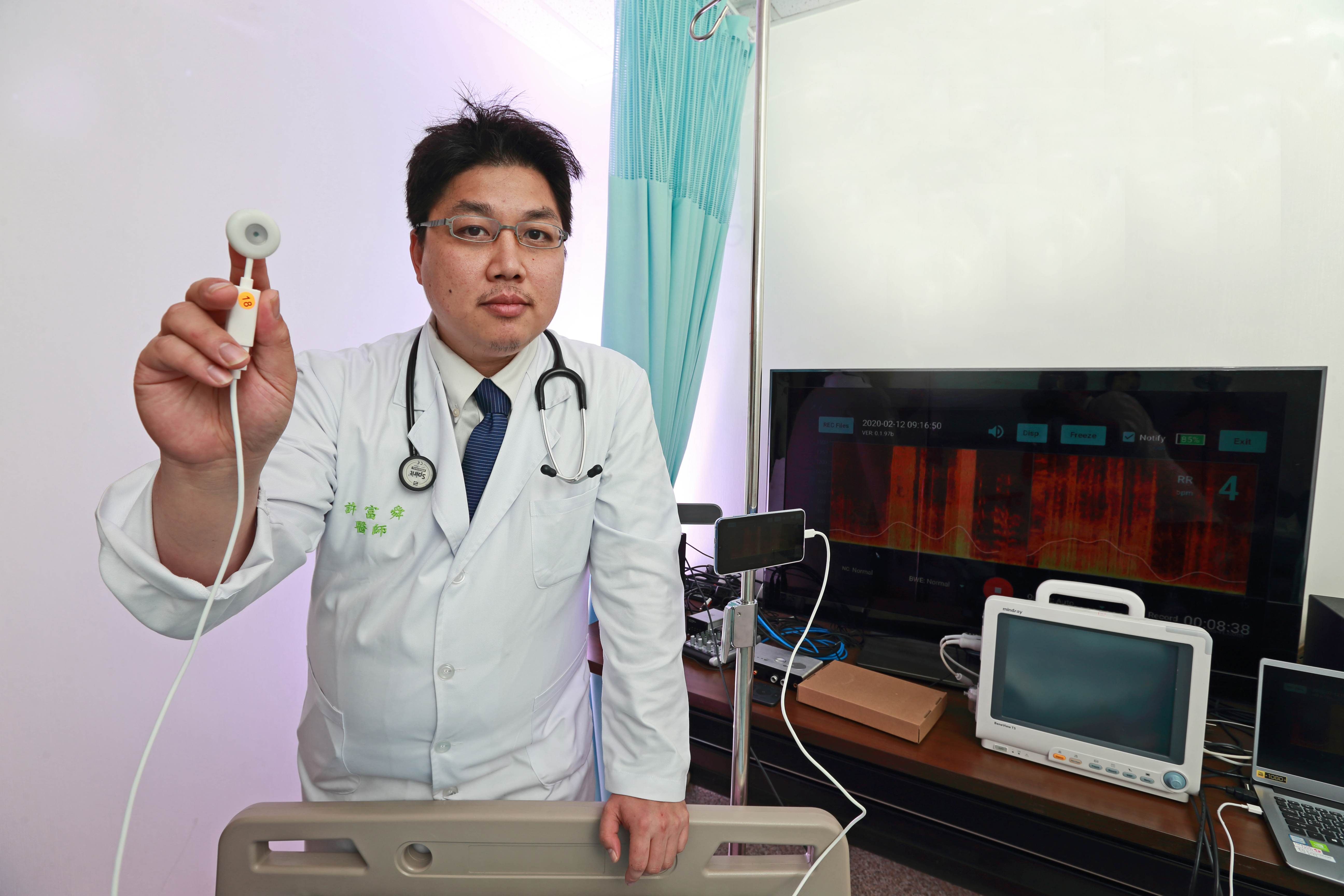An ‘AI stethoscope’ that is outfoxing COVID-19
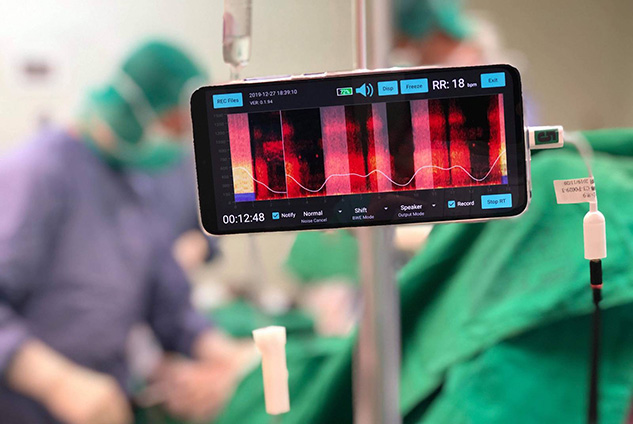
Source:Heroic-Faith Medical Science
Doctors in Wuhan were at a serious disadvantage in combating the new coronavirus, unable to get near their patients to listen to their lungs with a stethoscope without risking their health. An “AI stethoscope” system developed in Taiwan changed that.
Views
An ‘AI stethoscope’ that is outfoxing COVID-19
By Cathy Chiangweb only
Editor’s note: Read our latest stories on the COVID-19 global pandemic
“Everybody is in shock.” That was the text Heroic Faith Medical Science CEO Dr. Hsu Fu-shun received on his smartphone from a critical care department physician in Wuhan, China, in the second half of February.
The doctor who sent the message was working in a hospital that was only treating seriously ill new coronavirus disease (COVID-19) patients. All of the facility’s medical workers were wearing cumbersome, full-body protective gear that completely covered their ears, rendering the use of a stethoscope virtually impossible.
To address that need, the Wuhan hospital went through special channels to bring in Heroic Faith’s AI stethoscope known as the “Airmod” (short for “artificial intelligence respiratory monitoring device”). Doctors there were thrilled because the device enabled them to continuously monitor heart and lung sounds remotely, substantially reducing their risk of exposure to the highly contagious virus.
For some, it was a life saver. When the outbreak first began and people with coronavirus symptoms invaded the hospital, some intrepid doctors would examine patients with a standard stethoscope, listening for the sound of infiltrates around the lungs, one of the main symptoms of COVID-19.
As it turned out, “the doctors who actually listened [with stethoscopes] were all infected,” Hsu said.
Heroic Faith CEO Hsu Fu-shun (Photo by Chien-Tong Wang)
Founded two years ago, Heroic Faith leveraged Taiwan’s strength in both the health care and electronics sectors to develop this “remote stethoscope” system. Microelectronic sensor patches are fixed to a patient’s chest and can gauge the person’s respiration rate, and abnormal lung sounds such as wheezes (indicating narrowing airways), crackles (indicating fluid in air sacs), and “rhonchi” (a snoring sound indicating thickening bronchial tubes because of mucus). Those sounds are digitized and transmitted to a remote computer or smartphone.
The system was originally intended to monitor the breathing of patients under general anesthesia during an operation, but it unexpectedly found another use during the COVID-19 pandemic that has swept across the globe.
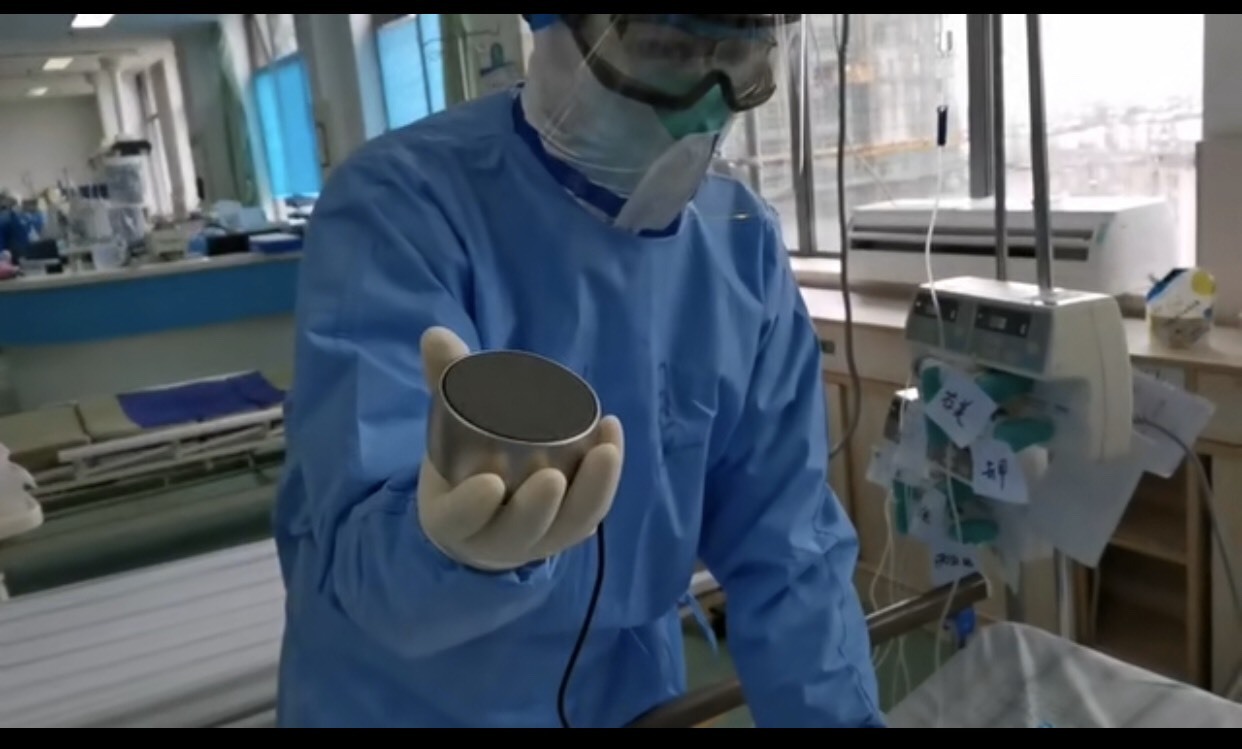
Medical workers in Wuhan could listen to patients’ lungs using the Airmod without removing their protective gear. This worker is holding up a speaker used in the system. (Source: Heroic-Faith Medical Science)
Bringing Stethoscopes into the Modern Era
Hsu, a physician specializing in critical care medicine of Far Eastern Memorial Hospital, has also worked at National Taiwan University Hospital and Taipei Veterans General Hospital, and that experience provided the inspiration for the startup company.
In his many years of clinical experience, he found that instruments had been designed that could detect and digitize heartbeats, blood pressure, and blood oxygen levels, but nothing had been done to bring the stethoscope into the 21st century and digitize respiratory auscultation – the sounds generated by the respiratory system.
“We have only been able to rely on patients’ descriptions of coughs and chest tightness. Even when doctors listen with a stethoscope, they are still making a subjective judgment, and clinical experience will affect that judgment,” Hsu said.
To address these clinical issues, Hsu, who is currently working toward a Ph.D. in biomedical electronics and bioinformatics at National Taiwan University, got the idea of developing a respiratory monitoring system.
He teamed up with Frank Wu, the co-founder of LCD monitor specialist AmTRAN Technology, and Heroic Faith Chief Technology Officer Tsai Fu-ji to create a cloud-based system incorporating hardware and monitoring data.
The three founded the company in 2018, and its first innovation was an adaptive noise-canceling auscultation system, called the Automated Chest Sound Monitor, applied to respiratory monitoring.
The company’s chief operating officer, Cheng Yuan-ren, said breathing sounds measure only 10 to 20 decibels, compared with around 70 decibels when people converse. To pick up that weak sound, the microelectronic sound sensor patches needed to be reduced in size. The patches also had to be made lighter, using materials such as plastic or foam, so that they could stay affixed to a patient’s chest. Through the company’s noise-canceling algorithm, the sounds are converted into a visible spectrogram, resulting in a respiratory monitoring system that “can be affixed easily, hear sounds clearly and identify them accurately.”
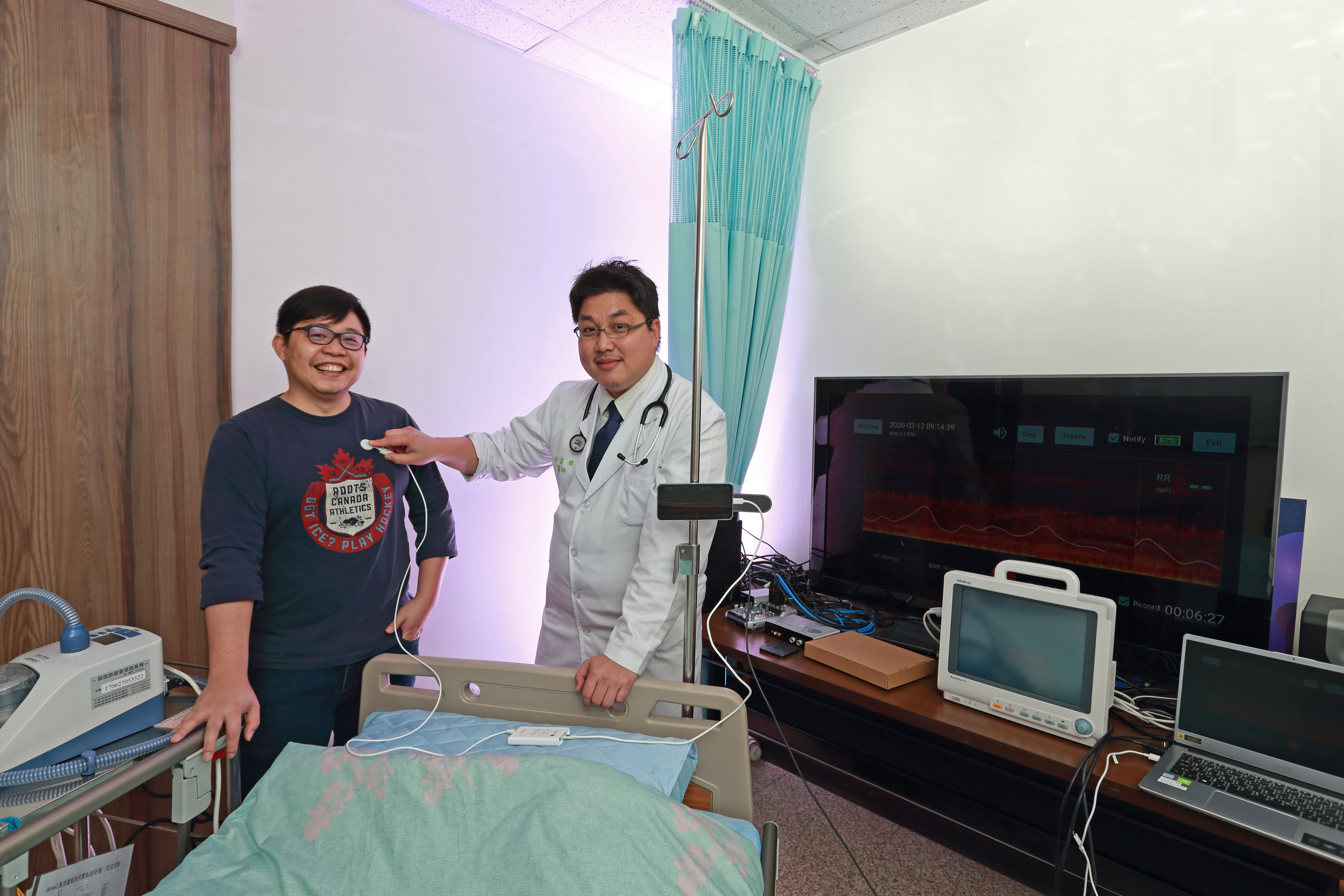
Getting the elite medical and electronics specialists on the Heroic Faith team on the same page proved to be a challenge, however. Doctors recognize respiratory activity by listening to sounds through a stethoscope, but engineers check the frequency and spectrum of frequencies generated electronically. Meshing the two fields required the widespread collection of sound samples in various clinical situations to develop benchmarks.
The company signed agreements with Taipei Medical University Hospital and Far Eastern Medical Hospital to conduct clinical research, and it worked with National Taiwan University Hospital by assisting in diagnoses and monitoring patients’ respiratory sounds together with clinical physicians. To date, it has collected more than 8,000 hours of audio, the largest known databank of respiratory sounds anywhere in the world.
In contrast to the average person, hospitalized patients tend to present more breathing abnormalities, known as adventitious breath sounds. They occur in about 10 to 20 percent of hospitalized patients, Hsu said, meaning that the audio his team collected was particularly favorable to be used as a clinical reference and in big data analysis in the future.
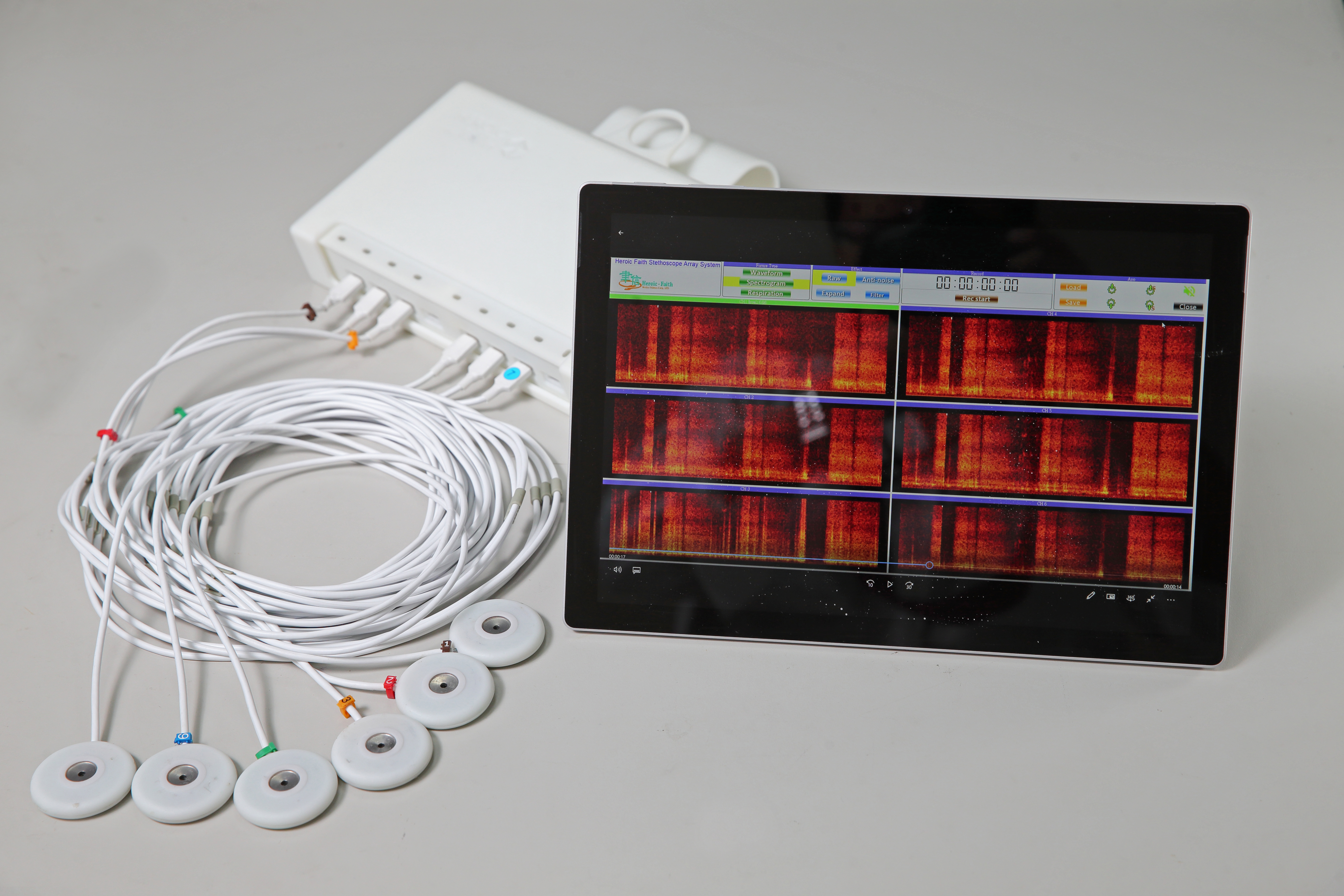
This groundbreaking AI stethoscope’s potential was evident last year when Heroic Faith took second place from among more than 300 entries in the RESI Innovation Challenge in San Francisco. The challenge is part of the RESI conference that matches early stage investors with innovative companies, ideas and products.
Going Clinical
Investor interest in the Airmod has since ebbed because of the COVID-19 pandemic, according to Heroic Faith’s Cheng, but inquiries about it have soared.
The experience with the Airmod in the Wuhan hospital demonstrated its effectiveness as a supplemental tool. Hsu said it was mainly used on seriously ill patients who had been intubated to care for them in a timely manner based on sounds from their lungs. If wheezes or cackles are heard, for example, drugs such as bronchodilators may be warranted for symptom control. The sounds may also help with the early identification of patients requiring a tracheostomy or even cardiopulmonary resuscitation to keep them from getting worse.
The system has also been deployed domestically for research purposes in cooperation with hospitals treating COVID-19 patients, according to Cheng. The system has accumulated 72 hours of respiratory sounds related to the new coronavirus and can clearly measure “wet” crackles (which sound like blowing air through a straw in a cup and creating bubbles), signaling the presence of pulmonary infiltrates. It can also detect when a patient’s breathing accelerates, helping doctors with their diagnosis.
Cheng said the Airmod is non-invasive and has received all necessary safety certifications, and can currently be used for research purposes with the agreement of a physician as long as the study has been approved by the hospital’s Institutional Review Board.
But it has yet to obtain final approval to be sold in Taiwan. The company expects it will receive the green light from the Taiwan Food and Drug Administration at the end of June, after which the Airmod can hit the domestic market.
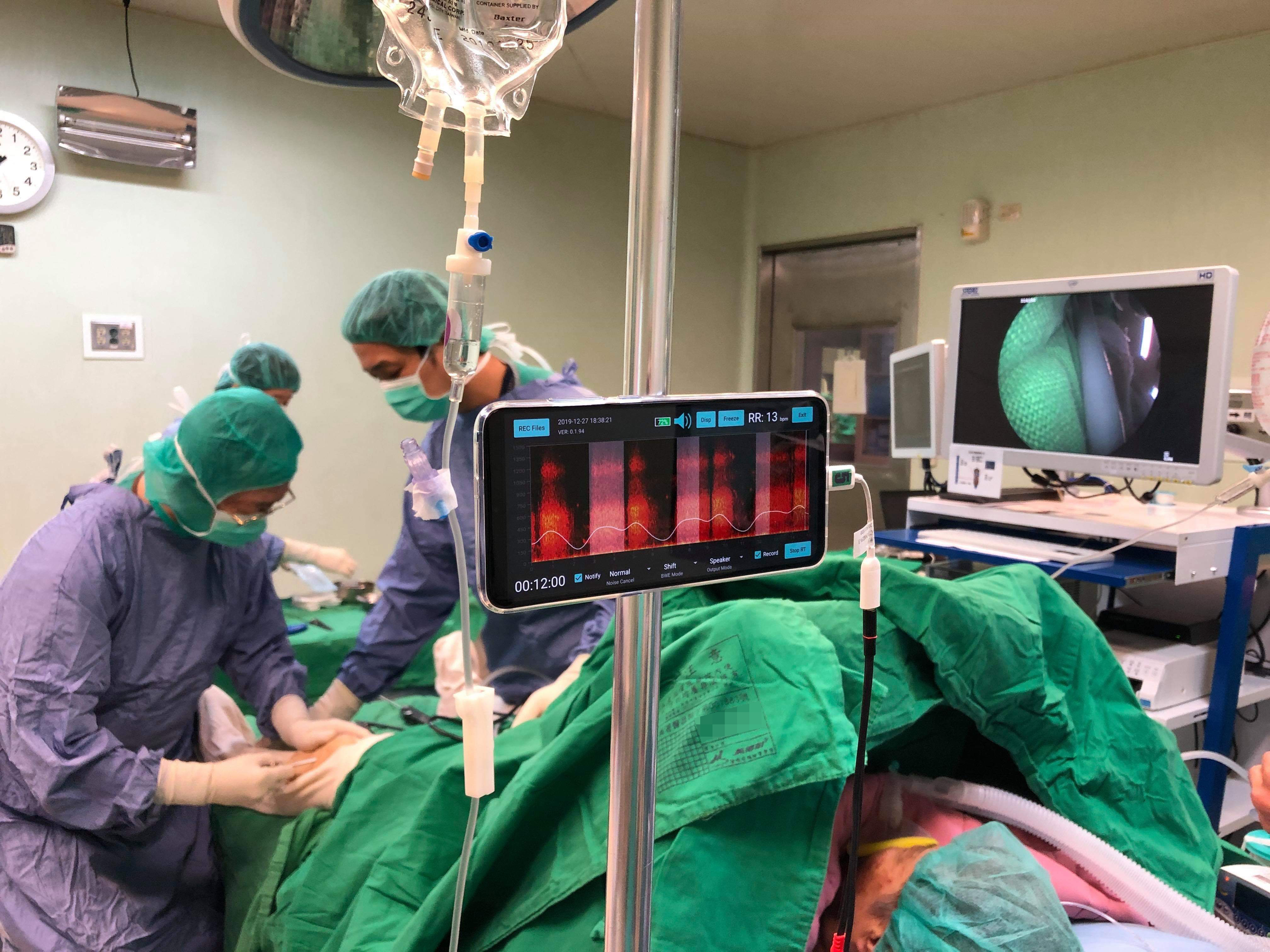
Even then, Heroic Faith will have a few hurdles to overcome. One involves security.
The electronic technology used in the AI stethoscope means doctors do not have to come in direct contact with patients to listen to their lungs, an example of how technology can help with epidemic prevention efforts, said former health minister and Heroic Faith consultant Lin Tzou-yien. That technology, however, potentially exposes the product to information security issues.
Eric Mao, the head of the Cybersecurity Technology Institute under the Institute for Information Industry, said medical information has major privacy implications, and security and confidentiality are high priorities. At the same time, main computer systems must be protected, and no openings can be allowed in the pursuit of collecting more data.
“If a medical center is shut down because of information security problems, it’s more dangerous than a bomb,” Mao said.
From a business perspective, a venture capitalist said Heroic Faith’s AI stethoscope faces regulatory hurdles and the challenge of scaling up production. It will also have to integrate its system with other medical electronics for clinical use, because “it’s not enough just to sell the respiration system,” the source said, suggesting adding other functions such as a pulse oximeter or blood pressure gauges to make the device more appealing to a broader market.
If Heroic Faith can address these issues, the system will be ideal not only for medical purposes but also for people quarantined at home or long-term care patients, giving it a wider path to success.
Have you read?
♦ COVID-19: Live updates
♦ Meet Peter Tsai, the Taiwanese Inventor Behind the N95 Mask
♦ Sensory Loss Used to Screen for Hidden Coronavirus Infections
♦ How Taiwan Fights COVID-19
♦ How to beat the coronavirus without the WHO? Ask Taiwan
Translated by Luke Sabatier
Uploaded by Judy Lu


